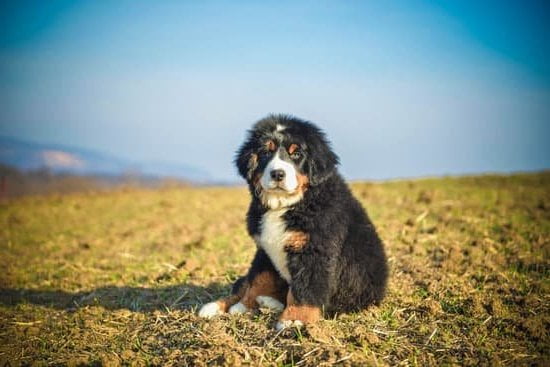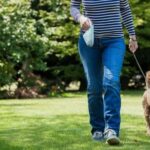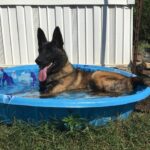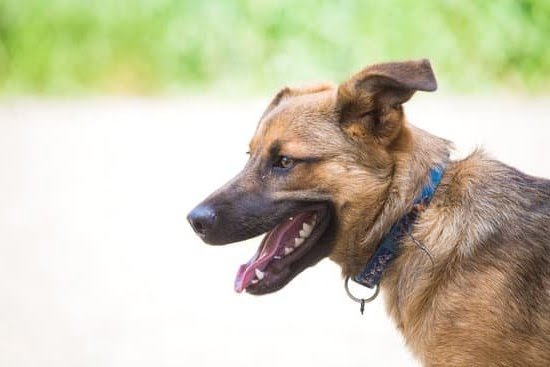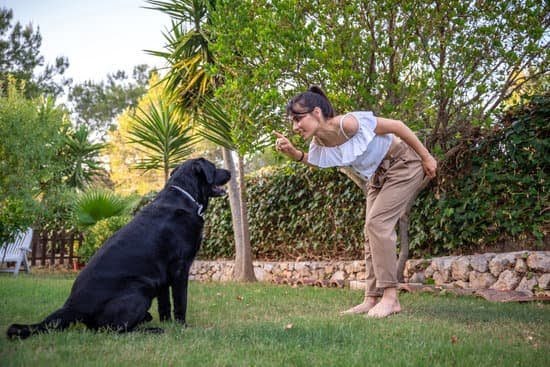Potty training your 1 year old dog is crucial for establishing good habits and maintaining a clean and comfortable living environment for both you and your furry friend. By teaching them to eliminate in the appropriate spot, you can avoid accidents, improve their overall behavior, and strengthen the bond between you and your pet.
In this article, we will guide you through the process of potty training your 1 year old dog, providing valuable tips, techniques, and strategies to ensure success.
As dogs reach their first year of age, they are still developing their physical and mental capabilities. Proper potty training during this stage can set a solid foundation for lifelong good behaviors. It is important to understand that every dog is unique and may respond differently to training methods. Therefore, it is essential to approach potty training with patience, consistency, and positive reinforcement.
Before diving into the practical steps of potty training, it is crucial to assess the current situation and identify any challenges or areas for improvement. This will allow you to tailor your approach based on your dog’s specific needs and tendencies. By addressing these challenges head-on, you can create an effective strategy that aligns with your dog’s individual learning style and personality.
In the following sections of this article, we will explore various aspects of potty training a 1 year old dog in detail. From establishing a consistent routine that includes regular potty breaks and meals to recognizing signs that indicate when your dog needs to eliminate – we will cover it all. Additionally, we will provide guidance on crate training techniques for successful potty training as well as advice on dealing with accidents and preventing future mishaps.
By following the guidance offered in this article, you can effectively potty train your 1 year old dog while fostering a positive relationship with them. Together, you can overcome any challenges that may arise during the process and celebrate every milestone achieved along the way. So let’s embark on this journey of potty training success and ensure that both you and your furry friend enjoy a happy, clean, and harmonious living environment.
Assessing the Current Potty Training Situation
One of the first steps in potty training your 1-year-old dog is to assess the current potty training situation. This involves identifying any challenges or areas for improvement in your dog’s potty habits. By understanding what you’re currently working with, you can develop a more targeted and effective potty training plan.
To assess the current situation, start by observing your dog’s behavior and potty habits. Take note of how often they are having accidents indoors, if they show any signs of needing to go outside, and if there are any specific triggers that lead to accidents. This will help you identify patterns and potential issues that may need to be addressed.
Creating a list can be helpful in organizing your observations and pinpointing specific challenges or areas for improvement. Here is an unordered list of different factors to consider when assessing your dog’s potty training situation:
- Frequency of accidents: How often does your dog have accidents indoors? Are they having accidents daily or only occasionally?
- Timing: Is there a certain time of day when accidents are more likely to occur? Do accidents tend to happen shortly after meals or playtime?
- Training consistency: Have you been consistent with your potty training efforts? How often do you take your dog outside for bathroom breaks?
- Signs of needing to go: Does your dog exhibit any specific behaviors or signals when they need to eliminate? Do they scratch at the door, whine, sniff around, or circle before having an accident?
- Location preferences: Does your dog have a preferred spot for eliminating? Do they consistently choose the same area in the house?
By taking the time to thoroughly assess the current potty training situation, you can gain valuable insights into what needs improvement and begin implementing strategies that will address these challenges effectively. Remember that every dog is unique, and identifying their individual needs and habits will set the foundation for successful potty training.
Establishing a Consistent Routine
One of the key elements in successfully potty training a 1 year old dog is establishing a consistent routine. Dogs thrive on routine and structure, and having set times for potty breaks and meals can greatly aid in their potty training progress. This section will provide some helpful tips on how to create a consistent routine for your dog’s potty breaks and meals.
First and foremost, it is important to establish regular meal times for your dog. Feeding your dog at the same time each day helps regulate their digestion and bowel movements, making it easier to predict when they may need to eliminate. In addition, setting specific times for meals can help you monitor your dog’s eating habits, ensuring that they are eating regularly and not overeating or undereating.
Next, you’ll want to determine a schedule for your dog’s potty breaks. Typically, dogs will need to eliminate shortly after waking up, after meals, after playtime or exercise, and right before bedtime. By taking your dog outside consistently at these specific times, you are providing them with ample opportunities to relieve themselves in an appropriate location.
To help keep track of these set times for potty breaks and meals, consider creating a daily schedule that outlines when each activity should occur. This could be as simple as a handwritten list or saved digitally on your phone or computer. Having this schedule visible and easily accessible will serve as a reminder for you to stick to the routine and ensure consistency.
Choosing the Right Spot and Designating it as the Potty Area
Importance of Choosing the Right Spot
When potty training your 1-year-old dog, it is crucial to choose the right spot and designate it as the designated potty area. This helps in creating a consistent routine and setting clear boundaries for your dog. The chosen spot should be easily accessible for both you and your dog and should provide a comfortable and convenient environment for them to eliminate.
Finding an Appropriate Location
Finding an appropriate location for the potty area requires careful consideration. You should choose an area that is easily accessible for your dog, preferably close to the main entrance or a door leading outside. This will make it easier for your dog to understand that this is the designated spot for elimination.
Additionally, consider the surface of the chosen location. Some dogs may prefer to eliminate on grass, while others may prefer a different surface such as gravel or mulch. Observe your dog’s behavior during potty breaks and take note of their preferences.
It’s also important to ensure that the chosen location is quiet and free from distractions as much as possible. Loud noises, other pets, or excessive foot traffic can make your dog feel uncomfortable and make it difficult for them to focus on their potty training.
Making the Potty Area Appealing
To encourage your 1-year-old dog to utilize the designated potty area, you can make it more appealing by following these tips:
- Keep the area clean: Regularly remove any feces or urine from the area to maintain cleanliness. Dogs have a strong sense of smell, so keeping the area odor-free will help them associate it with eliminating.
- Use scent markers: Consider using scent markers specifically designed for potty training dogs. These markers release pheromones that attract dogs to eliminate in that specific area.
- Provide comfort: Make sure there is ample space for your dog to comfortably eliminate. If using a designated potty pad, make sure it is large enough for your dog to move around on and doesn’t feel cramped.
- Consider privacy: Some dogs feel more comfortable eliminating in areas that provide them with privacy. You can create privacy by surrounding the potty area with plants or a small fence.
Remember, consistency is key when designating the potty area. By choosing the right spot and making it appealing for your 1-year-old dog, you are setting them up for success in their potty training journey.
Understanding your Dog’s Body Language
One crucial aspect of potty training a 1-year-old dog is understanding their body language and recognizing the signs that indicate they need to eliminate. Dogs have different ways of communicating their needs, and being able to interpret their body language can greatly facilitate the potty training process.
There are several common signs that your dog may exhibit when they need to go potty. One of the most obvious signs is circling or sniffing around a particular area, which indicates that they are searching for an appropriate spot to eliminate. Additionally, if your dog starts squatting or assuming a posture similar to the one they take when urinating or defecating, this is another clear indication that they need to go outside.
Another important aspect of understanding your dog’s body language is paying attention to any changes in their behavior or routine. Some dogs may become restless, agitated, or pace around when they need to eliminate. Others may start barking or scratching at doors or whining for attention. By observing these changes and patterns in your dog’s behavior, you can better anticipate when it’s time for them to go outside.
| Behavioral Cue | Body Language Indicator |
|---|---|
| Circling or sniffing around | Searching for an appropriate spot |
| Squatting or assuming posture similar to urination/defecation | Indicates immediate need to eliminate |
| Barking, scratching at doors, whining for attention | Signs of restlessness and urgency |
By being attentive to these behavioral cues and body language indicators, you can proactively take your dog outside before accidents occur. This will reinforce the habit of going potty outside and help them develop bladder control over time. Remember to always provide positive reinforcement when your dog eliminates in the appropriate spot, as this will motivate and encourage consistent behavior.
Understanding your dog’s body language is a crucial component of successful potty training. Recognizing the signs that indicate they need to eliminate allows you to anticipate their needs and prevent accidents indoors. By closely observing their behavior and providing timely outdoor opportunities, you can establish a strong foundation for effective potty training.
Positive Reinforcement Techniques
Positive reinforcement is an essential component of potty training a 1-year-old dog. By rewarding good behavior and encouraging consistent potty habits, you can effectively reinforce the desired behavior and motivate your dog to continue practicing proper elimination habits. Here are some effective positive reinforcement techniques that you can implement in your potty training routine.
Use Treats
One of the most popular methods of positive reinforcement is using treats as rewards for successful potty breaks. Whenever your dog eliminates in the designated spot, immediately reward them with a small, tasty treat. Make sure to use treats that your dog finds particularly enticing to further incentivize them. This positive association will encourage them to repeat the behavior in order to receive more treats.
Verbal Praise and Affection
Along with treats, verbal praise and affection are powerful tools in reinforcing good potty habits. When your dog successfully eliminates in the designated area, shower them with enthusiastic verbal praise such as “good boy/girl.” or “well done.”. Additionally, petting or hugging your dog after they eliminate can further strengthen their understanding that they have done something commendable.
Clicker Training
Clicker training is another effective positive reinforcement technique that can be used during potty training. The clicker serves as a marker to indicate to your dog that they have performed the desired behavior correctly. Start by associating the sound of the clicker with a reward (such as a treat).
When your dog eliminates in the right spot, immediately use the clicker followed by giving them a treat. This will help them associate the clicker sound with positive outcomes and reinforce their understanding of proper elimination habits.
Remember, consistency is key when implementing these positive reinforcement techniques. Always reward your dog immediately after they eliminate in the appropriate spot so that they make a clear connection between their behavior and the reward. By consistently providing positive reinforcement, you will encourage your 1-year-old dog to develop and maintain consistent potty habits.
Effective Strategies for Crate Training
Crate training can be an effective tool in potty training your 1-year-old dog. When used correctly, a crate provides a safe and comfortable space for your dog while also helping to reinforce good potty habits. Here are some strategies to effectively utilize crate training for potty training success:
- Introduce the Crate Gradually: Start by introducing your dog to the crate gradually, allowing them to explore it at their own pace. Make the crate a positive and inviting space by placing soft bedding, toys, and treats inside.
- Use Proper Sizing: Ensure that the crate is appropriately sized for your dog. It should be large enough for them to stand up, turn around, and lie down comfortably but not too spacious that they have room to eliminate in one corner and sleep in another.
- Establish a Routine: Set specific times for your dog’s meals, playtime, and potty breaks. Utilize the crate during times when you cannot closely supervise your dog, such as overnight or when you leave the house. This routine will help establish good bladder control and make it easier for your dog to hold their bladder until they are taken outside.
- Regularly Take Your Dog Outside: Take your dog outside immediately after they are let out of the crate and encourage them to eliminate in the designated potty area. Use verbal cues such as “go potty” to associate those words with the act of eliminating.
- Reward Good Behavior: When your dog successfully eliminates outside, provide them with praise and rewards such as treats or extra playtime. This positive reinforcement will reinforce their understanding that eliminating outside is desirable behavior.
- Avoid Using the Crate as Punishment: It’s important not to use the crate as a form of punishment, as this can create negative associations with being in the crate and hinder the potty training process.
- 7.Clean Accidents Thoroughly: If accidents happen inside the crate, it’s crucial to clean them thoroughly to remove any lingering smells. Use enzymatic cleaners specifically designed for pet urine to eliminate odors that may attract your dog to eliminate in the same spot again.
By implementing these effective strategies for crate training, you can effectively utilize a crate as a tool for potty training success. Consistency and positive reinforcement are key when using this method, so be patient and persistent throughout the process. With time and proper training, your 1-year-old dog will develop good potty habits and become fully potty trained.
Dealing with Accidents
Accidents are a common part of the potty training process, especially when dealing with a 1-year-old dog. It’s important to have effective strategies in place for quick cleanup and measures to minimize future mishaps. This section will provide some helpful tips and techniques to handle accidents and prevent them from happening again.
Quick Cleanup Tips
When accidents happen, it’s crucial to act fast to avoid odors and stains setting into carpets or furniture. Here are some quick cleanup tips:
- Use paper towels or absorbent cloths to blot up as much urine as possible.
- Avoid rubbing the affected area, as it can spread the mess further.
- Mix a solution of equal parts water and white vinegar, and use it to clean the soiled area. The acidic nature of vinegar helps neutralize odors.
- For solid waste, use gloves and a plastic bag to scoop it up, then clean the area with an enzymatic cleaner specifically designed for pet accidents.
- Consider using steam cleaners or carpet cleaning machines for more thorough cleaning.
Preventive Measures
Preventing accidents is essential for successful potty training. Here are some preventive measures you can take to minimize future mishaps:
- Supervise your dog closely: Keep an eye on your 1-year-old dog at all times, especially during training phases. If you notice signs that they need to eliminate (sniffing around, circling), immediately take them outside.
- Create confinement areas: Limiting access to certain parts of your home can help control where your dog eliminates. Use baby gates or crates in rooms where you can’t directly supervise them.
- Establish regular potty breaks: Stick to a consistent schedule of outdoor potty breaks so that your dog knows when and where they should eliminate.
- Reinforce positive behavior: Reward your dog every time they eliminate in the appropriate spot, whether it’s outside or in a designated indoor area.
- Restrict water and food before bedtime: Limit your dog’s water intake a few hours before bedtime to reduce the chances of accidents during the night.
By following these quick cleanup tips and preventive measures, you can effectively manage accidents and minimize future mishaps. Remember to be patient with your 1-year-old dog throughout the potty training process, as accidents are to be expected. The key is to remain consistent, use positive reinforcement, and create a reliable routine that will lead to potty training success.
Providing Ample Exercise and Mental Stimulation
One key aspect of potty training a 1-year-old dog that is often overlooked is the importance of providing ample exercise and mental stimulation. Just like humans, dogs need regular physical activity to help maintain their overall health and well-being. However, the role of exercise goes beyond just keeping your dog physically fit; it also plays a crucial role in potty training.
Regular exercise can help regulate your dog’s bowel movements, making it easier for them to establish a predictable bathroom routine. A tired dog is more likely to have regular and solid bowel movements, which can significantly aid in potty training efforts. Additionally, exercise helps stimulate the digestive system, encouraging your dog to eliminate waste more efficiently.
In addition to physical exercise, mental stimulation is equally important for potty training success. Dogs are intelligent animals that require mental engagement and stimulation to prevent boredom and destructive behavior. Mental activities such as puzzle toys, obedience training sessions, and interactive playtime can keep your dog engaged and mentally tired.
When a dog’s mind is occupied with stimulating activities throughout the day, they are less likely to focus on needing to eliminate in inappropriate areas. By providing both physical exercise and mental stimulation, you’re setting your pup up for success in their potty training journey.
Remember that every dog has different exercise needs based on their breed, age, and health condition. Consult with your veterinarian or an animal behaviorist to determine the appropriate amount of exercise and mental stimulation required for your 1-year-old dog’s specific needs.
Troubleshooting Common Challenges
Submissive urination and marking are common challenges that dog owners may face during the potty training process. Submissive urination refers to a submissive or fearful reaction by a dog, often seen as urination, when they feel anxious or intimidated. Marking, on the other hand, is when a dog leaves small amounts of urine in specific areas to establish their territory.
To address submissive urination, it is essential to create a calm and positive environment for your dog. Avoid scolding or punishing your dog when accidents happen, as this can increase anxiety and make the problem worse. Instead, focus on building your dog’s confidence through positive reinforcement techniques such as praise and rewards for good behavior. Gradually expose your dog to new people, environments, and experiences to help them overcome their fear.
If marking is an issue, it is important to understand that it is a natural behavior driven by instinctual needs to establish territory and communicate with other dogs. Neutering or spaying your dog can often reduce marking behaviors. Additionally, ensuring that your dog receives enough mental and physical stimulation can help minimize marking tendencies. Regular exercise and engaging activities can help release pent-up energy and redirect potential marking behavior.
Other potential issues that may arise during potty training include stubbornness, accidents in inappropriate locations, or difficulties in transitioning from indoor pads or newspapers to outdoor elimination. In these cases, consistency is key. Stick to the established routine of frequent potty breaks and positive reinforcement techniques. Supervise your dog closely indoors until they are fully trained and gradually transition them to outdoor elimination by taking them outside regularly and rewarding successful outdoor bathroom trips.
Potty training a one-year-old dog can be challenging at times due to certain behaviors like submissive urination, marking, or difficulty transitioning between indoor and outdoor elimination methods. However, with patience, consistency, positive reinforcement techniques, ample mental and physical stimulation for the pup, these challenges can be effectively addressed. Remember to celebrate success and maintain a lifelong positive potty training routine to ensure your furry friend continues to have good bathroom habits.
Gradual Transition to Outdoor Training
One of the key goals of potty training a 1 year old dog is to eventually transition them to eliminating outdoors. While it may seem challenging in the beginning, there are strategies you can use to help your dog understand that outdoor elimination is the ultimate goal.
Firstly, it’s important to gradually introduce your dog to the concept of outdoor elimination. Start by taking them outside to a designated potty area regularly throughout the day. This will help them associate this specific location with eliminating. Be patient and give your dog time to explore and sniff around before they go.
During this transition period, it’s crucial to closely observe your dog’s body language for signs they need to eliminate. Common signs include pacing, circling, sniffing the ground, or suddenly becoming restless. If you notice any of these signals, immediately take your dog outside to their designated potty area.
To reinforce the behavior of eliminating outdoors, it’s important to provide positive reinforcement when they do so successfully. Offer verbal praise and rewards such as treats or toys immediately after they eliminate in the correct spot. This will encourage them to repeat this behavior in the future.
As your dog becomes more comfortable with eliminating outdoors, gradually reduce the frequency of indoor potty breaks. Extend the time between each break while keeping a close eye on their behavior for any signs that they need to eliminate. Eventually, your goal should be for them to only eliminate outside.
Remember that accidents during this transition phase are normal and shouldn’t deter you from continuing with outdoor training. It’s important not to scold or punish your dog during these accidents as it can create fear or confusion around elimination. Instead, focus on reinforcing positive behavior when they eliminate in the correct spot.
Gradual Transition Tips
| Tips for Gradual Transition |
|---|
| Introduce outdoor potty area gradually, allowing the dog to become familiar with it |
| Observe dog’s body language for signs they need to eliminate and take them outside immediately |
| Provide positive reinforcement (verbal praise, treats, toys) when the dog eliminates outdoors |
| Gradually reduce frequency of indoor potty breaks while monitoring behavior closely |
| Acknowledge accidents but avoid punishing or scolding the dog |
Conclusion
Potty training a 1-year-old dog can be a challenging process, but with patience and consistency, it is achievable. Throughout this article, we have discussed various strategies and techniques to help you successfully potty train your furry friend. Now that you have a solid foundation of knowledge on the subject, it’s time to celebrate your success and maintain a lifelong positive potty training routine.
Firstly, take a moment to celebrate the milestones that you and your dog have achieved together during the potty training process. Recognize the progress they have made and acknowledge the effort you have put in as well. Whether it’s using their designated spot consistently or having fewer accidents, every small victory deserves acknowledgment. Remember that training takes time and setbacks may occur, so don’t get discouraged if there are occasional slip-ups.
To maintain a successful potty training routine throughout your dog’s life, it is essential to continue practicing consistency and positive reinforcement. Dogs thrive on routine, so make sure to stick to their established schedule for potty breaks and meals. Consistency will reinforce their understanding of where and when they should eliminate.
Additionally, keep using positive reinforcement techniques to reward good behavior. Praise them enthusiastically when they use their designated potty area correctly and give them treats or verbal affirmations. This consistent positivity will strengthen their association between proper elimination behavior and rewards.
Lastly, remember that accidents may still happen occasionally even after successful potty training. In such cases, remain calm and address the situation promptly by cleaning up the mess properly using pet-friendly cleaning products. By doing so without anger or punishment towards your dog, you will ensure that they associate only positive experiences with going potty.
Overall, maintaining a lifelong positive potty training routine requires dedication from both you and your canine companion. By celebrating small victories along the way, remaining consistent in your routines, utilizing positive reinforcement techniques, addressing accidents appropriately, and gradually transitioning towards outdoor elimination goals too, you can ensure a successful and lifelong positive potty training experience for your 1-year-old dog.
Frequently Asked Questions
Is it too late to potty train a 1 year old dog?
It is not too late to potty train a 1 year old dog, although it may require more time and patience compared to starting the training at a younger age. One-year-old dogs are still capable of learning and adapting to new behaviors, so with consistent training and positive reinforcement, you can successfully teach them appropriate bathroom habits.
Keep in mind that older dogs may have developed some ingrained behaviors, so it will be important to be consistent and persistent with the training process.
Can a 1 year old be fully potty trained?
Yes, a 1 year old dog can absolutely be fully potty trained with the right approach and consistency. While some breeds may learn faster than others, it is never too late for a dog to learn proper bathroom habits.
The key lies in providing clear expectations, establishing a routine, and using positive reinforcement methods such as treats or praise when they eliminate in the appropriate area. Consistency is vital throughout the process by taking your dog out frequently (especially after meals or naps) and closely supervising them indoors until they establish good habits.
How do I train my 1 year old dog to pee?
Training a 1 year old dog to pee involves several steps and consistent effort on your part. First, establish a designated bathroom area for your dog outside where you want them to eliminate. Take your dog outside on a leash regularly and wait for cues that they need to go – sniffing around or circling are common signs. When they begin peeing in the designated area, use verbal cues (such as “go pee”) consistently each time they eliminate there.
Reward your dog immediately after they finish peeing with treats or verbal praise to reinforce this desired behavior. Avoid scolding or punishing accidents indoors as it might confuse or scare your pup. Be patient, consistent, and attentive during this training period

Welcome to the blog! I am a professional dog trainer and have been working with dogs for many years. In this blog, I will be discussing various topics related to dog training, including tips, tricks, and advice. I hope you find this information helpful and informative. Thanks for reading!

